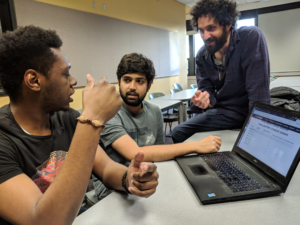Winning Blockchain Challenge team includes DAC student Arjun Choudhry

From left to right: Ikechukwu Dimobi, Arjun Choudhry, and Zachary Gould
A three-member student-driven team that includes Arjun Choudhry, a student at the Discovery Analytics Center, has won first place in the design phase of the Virginia Tech Blockchain Challenge led by the Department of Computer Science and made possible in part through a generous gift from Block.one, a leader in providing high-performance blockchain solutions. The award carries a $1,000 prize.
Choudhry is a master’s student in computer science advised by Naren Ramakrishnan. His teammates are Zachary Gould, a Ph.D. student in building construction advised by Georg Reichard; and Ikechukwu Dimobi, a master’s student in electrical engineering advised by Saifur Rahman.
The challenge posed this problem for the team: Virginia Tech plans to expand its campus and double the current population of students and staff by 2047. This growth will exacerbate the current challenge of meeting peak-energy demands while accommodating an increasing amount of distributed energy resources such as solar panels. Utilities must learn how to encourage energy efficient practices to reduce demand and how to effectively coordinate interaction between consumers, renewable energy sources, and the grid. With earnings currently communicated on existing monthly billing cycles, existing solutions such as net-metering, feed-in-tariffs and demand response are neither transparent nor resolute enough.
In their winning design solution, Choudhry, Gould, and Dimobi developed a secure energy distribution platform for multi-family apartment buildings and neighborhoods that share a solar panel array.
They use smart contracts on the EOSIO platform to transparently and dynamically distribute revenue using tokens. At every timestep, each resident is allocated tokens worth a fair portion of total energy production or loses tokens based on consumption, hence incentivizing energy efficient behavior. The total net energy supply or demand from the community would then be transacted with the local utility.
This paves the way towards community scale solar where residents can equitably share in both costs and profits, Choudhry said.
The three students are now working on an April 24 deadline to submit a plan to implement their design. The second phase winner will be notified on May 2.
Judging for both the first and second phases of the competition includes a maximum of five points each for use of EOSIO technology, creativity, impact, design and usability, and functionality.